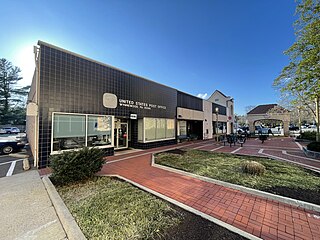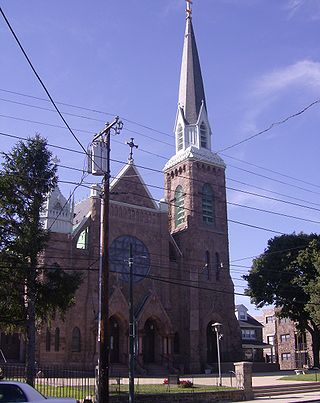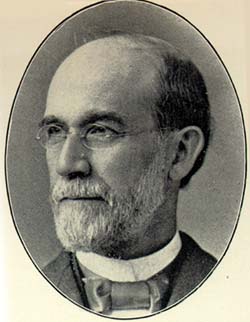Related Research Articles

Narberth is a borough in Montgomery County, Pennsylvania. It is one of many neighborhoods on the historic Philadelphia Main Line. The population was 4,282 at the 2010 census.

Germantown is an area in Northwest Philadelphia, Pennsylvania. Founded by Palatine, Quaker, and Mennonite families in 1683 as an independent borough, it was absorbed into Philadelphia in 1854. The area, which is about six miles northwest from the city center, now consists of two neighborhoods: 'Germantown' and 'East Germantown'.

Chestnut Hill is a neighborhood in the Northwest Philadelphia section of Philadelphia, Pennsylvania, United States. It is known for the high incomes of its residents and high real estate values, as well as its private schools.

Germantown Friends School (GFS) is a coeducational independent PreK–12 school in the Germantown neighborhood of Philadelphia, Pennsylvania, in the United States under the supervision of Germantown Monthly Meeting of the Religious Society of Friends (Quakers). It is governed by a School Committee whose members are drawn from the membership of the Meeting, the school's alumni and parents of current students and alumni. The head of school is Dana Weeks.

Wynnewood is a suburban unincorporated community, located west of Philadelphia, straddling Lower Merion Township in Montgomery County, Pennsylvania and Haverford Township in Delaware County, Pennsylvania, United States.

Holmesburg began as a Village within Lower Dublin Township, Pennsylvania. It is now a neighborhood in the Northeast section of Philadelphia, Pennsylvania, United States. Holmesburg was named in Honor of Surveyor General of Pennsylvania Thomas Holme, who was a cartographer.

Old City is a neighborhood in Center City, Philadelphia, Pennsylvania, United States, near the Delaware River waterfront. It is home to Independence National Historical Park, a dense section of historic landmarks including Independence Hall, the Liberty Bell, the First Bank of the United States, the Second Bank of the United States, and Carpenters' Hall. It also includes historic streets such as Elfreth's Alley, dating back to 1703.

Torresdale, also formerly known as Torrisdale, is a neighborhood in the Far Northeast section of Philadelphia, Pennsylvania, United States. Torresdale is located along the Delaware River between Holmesburg and Bensalem Township in neighboring Bucks County.

William Penn Charter School is an independent school in Philadelphia, Pennsylvania. It was founded in 1689 at the urging of William Penn as the "Public Grammar School" and chartered in 1689 to be operated by the "Overseers of the public School, founded by Charter in the town and county of Philadelphia" in Pennsylvania. It is the oldest Quaker school in the world, the oldest elementary school in Pennsylvania, and the fifth oldest elementary school in the United States following The Collegiate School, Boston Latin School (1635), Hartford Public High School (1638), and Roxbury Latin (1645).

The Episcopal Academy, founded in 1785, is a private, co-educational school for grades Pre-K through 12 based in Newtown Square, Pennsylvania. Prior to 2008, the main campus was located in Merion Station and the satellite campus was located in Devon. The Newtown Square facility is on a 123-acre (0.50 km2) campus. The Academy is affiliated with the Episcopal Church.

The Connecting Railway was a subsidiary of the Pennsylvania Railroad, incorporated to build a connection between the Philadelphia and Trenton Railroad and the PRR in the city of Philadelphia.
The Association of Delaware Valley Independent Schools (ADVIS) is a voluntary, non-profit consortium of independent schools in the Delaware Valley area of the United States. With headquarters in Bryn Mawr, Pennsylvania, the Association currently has 134 members located throughout eastern Pennsylvania, northern Delaware, and central and southern New Jersey.

G. W. & W. D. Hewitt was a prominent architectural firm in the eastern United States at the turn of the twentieth century. It was founded in Philadelphia in 1878, by brothers George Wattson Hewitt (1841–1916) and William Dempster Hewitt (1847–1924), both members of the American Institute of Architects. The firm specialized in churches, hotels and palatial residences, especially crenelated mansions, such as Maybrook (1881), Druim Moir (1885–86) and Boldt Castle (1900–04).
The Philadelphia Public League (PPL) is the interscholastic sports league for the public high schools of Philadelphia, Pennsylvania. The league traces its origin to 1901, with the formation of the Philadelphia Interscholastic League, a conference encompassing all the city's high schools, public and private. Prior to this, the public and private schools in the area had been competing among themselves for several years in a number of sports, including football and basketball. Basketball and track and field were the first recognized sports in 1901, but football, although not formally on the schedule, engaged all the same teams, and newspapers usually recognized the school with the best record as the informal interscholastic champion. In 1902, baseball and crew were added to the schedule.

Addison Hutton (1834–1916) was a Philadelphia architect who designed prominent residences in Philadelphia and its suburbs, plus courthouses, hospitals, and libraries, including the Ridgway Library, now Philadelphia High School for the Creative and Performing Arts, and the Historical Society of Pennsylvania. He made major additions to the campuses of Westtown School, George School, Swarthmore College, Bryn Mawr College, Haverford College, and Lehigh University.

The 1688 Germantown Quaker Petition Against Slavery was the first protest against enslavement of Africans made by a religious body in the Thirteen Colonies. Francis Daniel Pastorius authored the petition; he and the three other Quakers living in Germantown, Pennsylvania, Garret Hendericks, Derick op den Graeff, and Abraham op den Graeff, signed it on behalf of the Germantown Meeting of the Religious Society of Friends. Clearly a highly controversial document, Friends forwarded it up the hierarchical chain of their administrative structure—monthly, quarterly, and yearly meetings—without either approving or rejecting it. The petition effectively disappeared for 150 years into Philadelphia Yearly Meeting's capacious archives; but upon rediscovery in 1844 by Philadelphia antiquarian Nathan Kite, latter-day abolitionists published it in 1844 in The Friend, in support of their antislavery agitation.
The Union Quakers of Philadelphia were a professional independent football team, based in Philadelphia, Pennsylvania, in 1921. The team evolved from a number of pro players who played with the Union Club of Phoenixville during their 1920 season. During their only season of operation, the club won the "Philadelphia City Championship". All of the team's home games were played at the Baker Bowl.
References
- ↑ "What We Do". The School District of Philadelphia. Retrieved 25 October 2019.
- ↑ "Welcome from the Head of School | Holmesburg Christian Academy". www.holmesburgchristian.org. Archived from the original on 2016-04-27.
- ↑ "Friends Schools League" . Retrieved 4 April 2012.
- ↑ "Directions Archived 2015-04-02 at the Wayback Machine ." Japanese Language School of Philadelphia. Retrieved on March 30, 2014. "The Japanese Language School of Philadelphia utilizes the campus of: Friends Central School 1101 City Avenue, Wynnewood, PA"
- ↑ "Community Profile Archived 2015-02-02 at the Wayback Machine ." Lower Merion Township. Retrieved on April 30, 2014. (contains maps of Lower Merion).